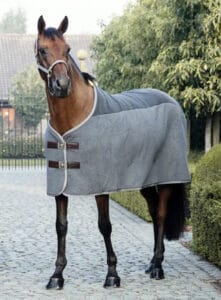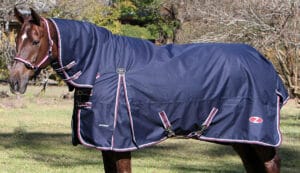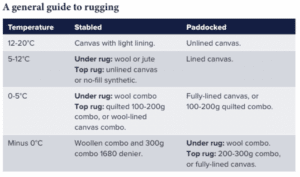There’s no doubt about it – winter has arrived. And as temperatures go down, it’s time to rug up, writes SUZY JARRATT.
So what should the best dressed horse be wearing this winter? Before you decide, there are so many factors to consider. Are they stabled or turned out? Clipped, hairy, old, or very young? A shaggy plump pony, or a sleek show hack?
Selecting appropriate apparel can be confusing, confronting and costly. Here is a simple overview of a complex market flooded with quilted combos, woolly warmers and padded paddock rugs.
But first, remember horses don’t lose heat as rapidly as we do, so just because you may be feeling chilly doesn’t mean your horse is. It’s actually much easier for a horse to warm up than cool down. If they are feeling cold their coat hairs will be standing up – and if they’re rugged and you want to check that they’re comfortable put your hand under the rug to feel if their wither is warm.
There are several main reasons why we use rugs at this time of year: to keep our horses warm, dry and clean; and also so we can clip them, thus reducing the risk of over-heating during training or competition and making them easier to clean off afterwards.
Although this may sound obvious, always start with lighter rugs and move to thicker rugs as it gets colder. Don’t overdo it when the weather first starts to cool.
Under Rugs
Wool: Wool provides warmth without weight by trapping heat in thick natural fibres while allowing the skin to breath.
Polar Fleece: This is primarily designed to wick away moisture and dry your horse’s coat after exercising, or for use when standing in the float, or while being shod. If worn over long periods some polar fleeces can pull back putting pressure on the wither.

Kentucky Horsewear Heavy Fleece Rug (Available from Trailrace).
Jute: Similar to hessian, jute’s natural fibres are slightly rough. A jute rug rubs against the horse’s coat as they move, acting like a brush and helping to shed the coat and promote shine.
Cotton: Cotton can be used under a waterproof turnout rug to help keep the rug clean, and provide extra warmth and more comfort. Some saddleries do sell 100 percent cotton but, more often than not, these rugs are a mixture of cotton and polyester, or cotton drill which is a breathable durable fabric.
Moleskin: Moleskin is thicker than standard cotton and brushed for extra warmth.
Heavy Rugs – Turnout
Burgundy turnout rug with matching neck rug (Available from Leader Equine).
Wool-lined ripstop canvas: These durable rugs can last multiple seasons. No canvas rug is 100 per cent waterproof but they’re still excellent in providing effective weather protection.
Polyester: Light to handle, waterproof and can be used as an all-in-one solution, without the need for heavy layers in winter. They dry out quickly after wet weather, but are not as breathable as natural fabrics so they retain more heat. The material in polyester rugs is rated by the thickness of the individual thread used in the weave, referred to as the denier and designated with a ‘D’ e.g. 1200D. Essentially the higher that number the stronger the material, so if you have a horse who’s mischievous in the paddock or has a rug-ripping companion the stronger the denier the better!
Polyester rugs also display labels indicating how many grams of polyfill they contain. Polyfill is similar to the material used to stuff toys and cushions. It comes in long flat lengths and its purpose is to slow the loss of radiant heat out of the rug and away from the horse. A rug labelled 200 grams of polyfill means that every square metre of polyfill lining weighs 200 grams. A polyester rug this heavy will be warmer than a 300 gram woollen rug or, to use a human analogy, a woollen jumper is a good base layer but a filled puffer jacket is much warmer.

A medium weight combo with contrasting binding (Available from Zilco Australia).
Neck rugs or Combos: For added protection from wintery weather, consider adding a matching neck rug to your horse’s wardrobe, or go for a combo, a rug with a permanently attached neck rug.
Stable Rug
Stable rugs provide extra warmth to a stabled horse, and are not waterproof. Usually quilted or padded, they’re available in a range of weights. To protect your horse’s shoulders from rug rub, choose a rug with a fleece neck collar, or opt for a satin or sheepskin bib.
Of course if your horse is stabled, but unclipped, he won’t require so much rugging.
Everyone has an opinion about this subject. Hopefully we’ve provided you with a basic guide which will assist in your search for the most appropriate winter rug without getting too hot under the collar!

Feature image: Cosy stable rug with fleece neck collar (Available from Horseware Australia).




